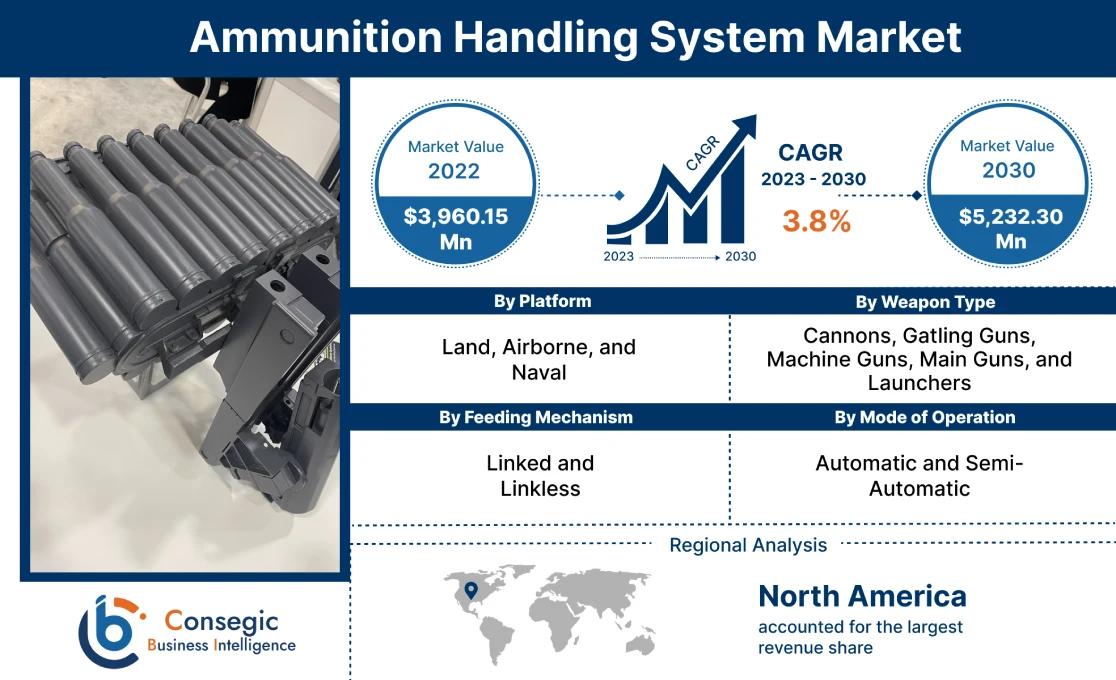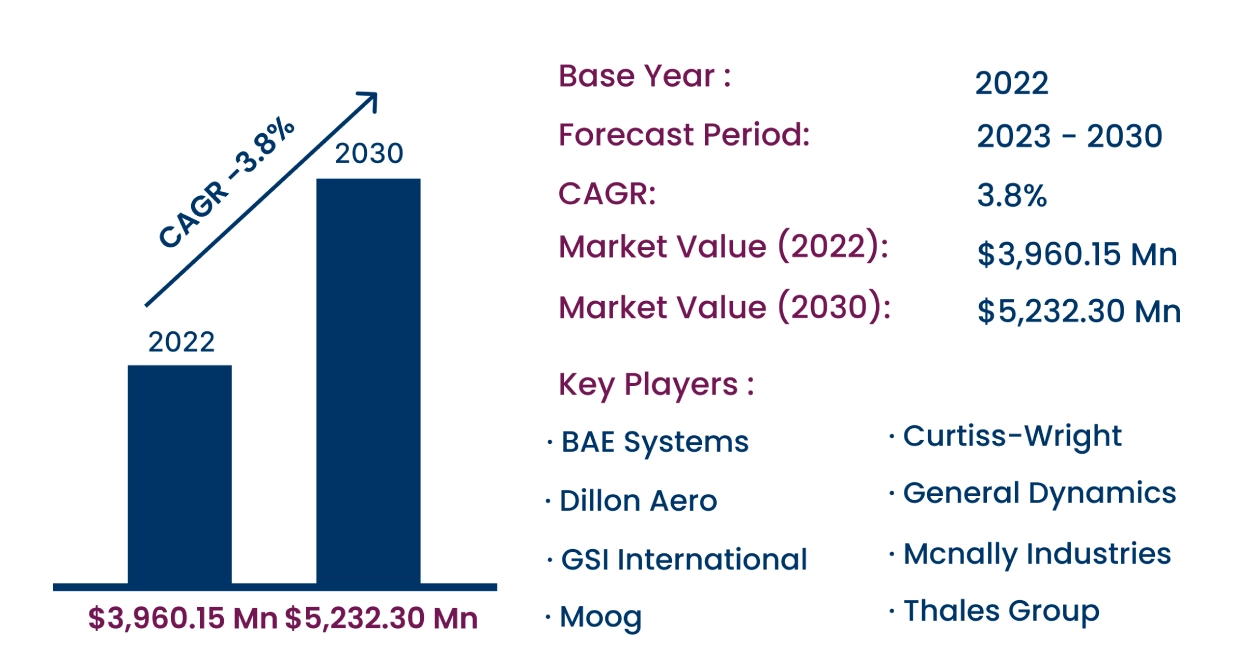- Summary
- Table Of Content
- Methodology
Ammunition Handling System (AHS) Market Introduction :
Ammunition Handling System (AHS) Market is estimated to reach over USD 5,232.30 Million by 2030 from a value of USD 3,960.15 Million in 2022, growing at a CAGR of 3.8% from 2023 to 2030.
Ammunition Handling System (AHS) Market Definition & Overview:
An Ammunition Handling System (AHS) refers to a set of mechanisms, equipment, and procedures used to safely and efficiently handle various types of ammunition. The primary purpose of an ammunition handling system is to facilitate the storage, transportation, loading, and unloading of ammunition while minimizing risks associated with mishandling and accidents. Therefore, ammunition handling systems are employed in military applications, including armored vehicles, naval vessels, aircraft, and military bases.
Ammunition Handling System (AHS) Market Insights :
Key Drivers :
Increasing demand for safety and security during ammunition storage is propelling the market growth
The ammunition handling system plays a crucial role in minimizing the risks associated with handling and storing ammunition. Ammunition for weapons ranging from 0.22 caliber bullets to GPS-guided missiles comprises of an explosive charge that has the tendency to explode due to improper storage. Moreover, ammunition handling system ensures that the infrastructure and containers used for ammunition storage are designed to withstand accidents or external threats. For instance, in April 2023, U.S. Department of Defense announced new security assistance for Ukraine, including ammunition for a wide range of weapons. Consequently, the increasing demand for safe and efficient storage of varied ammunitions by means of ammunition handling system is driving the market growth.
Rising investments by government and defense organizations is driving the market growth
The growing need to ensure the availability of necessary tools and infrastructure to handle ammunition safely, efficiently, and rapidly is driving the growth of ammunition handling system market. Governments and defense organizations worldwide are allocating funds to different wings of military departments to upgrade defense equipment, vehicles, and weapon systems. Moreover, governments across countries are taking several initiatives to enhance logistics and support systems in the military & defense industry. Additionally, the defense organizations are procuring military weapons including Artillery Rocket Systems, Unmanned Aerial Vehicles (UAVs), and additional ammunition to meet the growing demands of country's security. For instance, in March 2023, U.S. Department of Defense transported military equipment and weapons worth up to USD 400 million to Ukraine to aid its defense against the Russian invasion. Thus, the rising investments by government and defense organizations to upgrade military equipment, vehicles, and weapon systems is accelerating the growth of the ammunition handling system market.
Key Restraints :
Safety restrictions associated with transportation of ammunition is hindering the market growth
Transportation of ammunition is subject to follow specific regulations and restrictions, especially in air travel. Airlines and regulatory authorities have guidelines on the quantity, packaging, and declaration requirements for transporting ammunition. Moreover, the international transfer of ammunition is regulated by various arms trade agreements and treaties. Such agreements and treaties impose restrictions or control measures on the transfer of ammunition between countries, thereby restraining the growth of ammunition handling system.
Future Opportunities :
Adoption of high-power electromagnetic weapons is anticipated to drive the market growth
The adoption of high-power electromagnetic weapons in military & defence operations is expected to present potential opportunities for the growth of ammunition handling system market. Manufacturers are gradually developing laser systems to disable the military of an enemy nation. As a result, the Defence Advanced Research Projects Agency (DRPA) in the United States along with Naval Research Lab (NRL), Air Force Research Lab (AFRL), and Army Research Lab (ARL) are involved in the production of non-nuclear electromagnetic pulses (EMPs) and microwave weapons. Consequently, the adoption of electromagnetic warfare hardware including high-power electromagnetic weapons in military & defence sector is expected to drive the ammunition handling system market growth during the forecast period.
Integration of automation and robotics with Ammunition Handling System (AHS)
The integration of automation and robotics with ammunition handling system is expected to present potential opportunities for the growth of ammunition handling system market. Automated systems are used to enhance the speed, precision, and safety of ammunition handling processes. Moreover, integration of robotics into the manufacturing process allows firearms and ammunition manufacturers to meet the increasing demand for weapons along with decreasing workplace accidents and worker risk during the manufacturing process. As a result, the adoption of robotic arms, conveyor systems, and autonomous vehicles for handling ammunition for military operations is expected to streamline ammunition loading, unloading, and distribution operations.
Ammunition Handling System (AHS) Market Report Insights :
| Report Attributes | Report Details |
| Study Timeline | 2017-2030 |
| Market Size in 2030 | USD 5,232.30 Million |
| CAGR (2023-2030) | 3.8% |
| By Platform | Land, Airborne, and Naval |
| By Weapon Type | Cannons, Gatling Guns, Machine Guns, Main Guns, and Launchers |
| By Feeding Mechanism | Linked and Linkless |
| By Mode of Operation | Automatic and Semi-Automatic |
| By Region | Asia-Pacific, Europe, North America, Latin America, Middle East & Africa |
| Key Players | BAE Systems, Boeing, Calzoni, Curtiss-Wright, Dillon Aero, General Dynamics, General Dynamics Corporation, GSI International, Lockheed Martin, Mcnally Industries, Meggitt Defense Systems, Moog, Nobles Worldwide, Raytheon, Standard Armament, Thales Group. |
Ammunition Handling System (AHS) Market Segmental Analysis :
Based on the Platform :
Based on the platform, the ammunition handling system market is trifurcated into land, airborne, and naval. The land segment accounted for the largest revenue share in the year 2022. The growing number of land-based systems including armoured vehicles, artillery systems, infantry fighting vehicles, and main battle tanks are driving the growth of the ammunition handling system market. The aforementioned systems are used to handle, store, and distribute various types of ammunition for ground forces. For instance, in February 2023, Norwegian Procurement Agency signed collaborated with Krauss-Maffei Wegmann (KMW) to supply 54 Leopard 2 main battle tank to the Norwegian armed forces. Thus, the increasing demand for enhanced operational efficiency and transportation of ammunition is driving the growth of the ammunition handling system market.
The airborne segment is anticipated to witness fastest CAGR growth during the forecast period. The increasing demand for lightweight and compact ammunition handling system solutions for safe and efficient handling of ammunition during aerial warfare is driving the growth of the ammunition handling system market. Airborne military vehicles including military helicopters, transport aircraft, and unmanned aerial vehicles (UAVs) are deployed in airborne defence operations, air-to-ground support missions, and aerial reconnaissance. Furthermore, the integration of ammunition handling system solutions with advanced communication systems to streamline the military operations is expected to drive the ammunition handling system market growth during the forecast period.
Based on the Weapon Type :
Based on the weapon type, the ammunition handling system market is segregated into cannons, gatling guns, machine guns, main guns, and launchers. The machine guns segment accounted for the largest revenue share of 31.21% in the year 2022. Machine guns are fully automatic rifled firearms deployed in military & defence operations for sustained direct fire with rifle cartridges. Machine guns provide a significant increase in firepower on the battlefield. For instance, in September 2021, FN Herstal introduced a new FN EVOLYS ultralight machine gun that allows both full-automatic suppressive fire and semi-auto fire for point target engagement. Consequently, the increased firepower of machine guns is driving the growth of this segment.
Gatling guns are expected to register fastest CAGR growth during the forecast period. Gatling guns are designed for rapid-firing, containing multiple-barrel firearms that produces high rates of fire. Gatling guns are used to ensure continuous feeding, alignment, and loading of ammunition into the Gatling gun's rotating barrels. Thus, the growing use of Gatling guns in military aircraft, ground-based air defence systems, and naval applications is driving the growth of the ammunition handling system market.
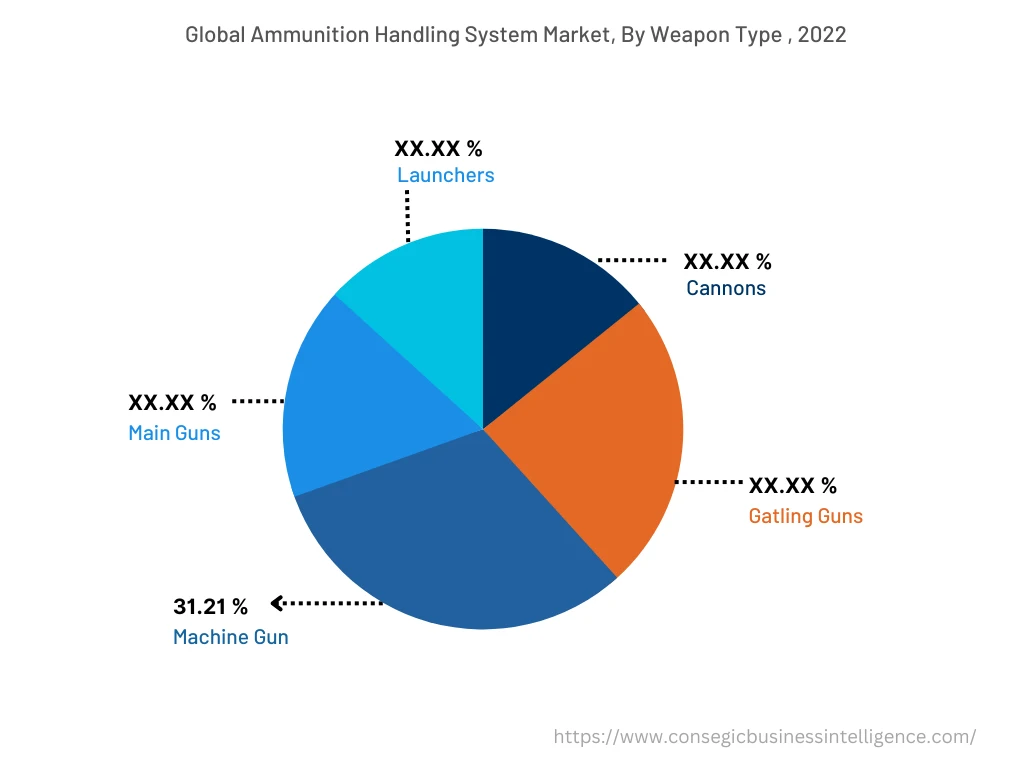
Based on the Feeding Mechanism :
Based on the feeding mechanism, the ammunition handling system market is bifurcated into linked and linkless. Linked segment accounted for the largest revenue share in the year 2022. Linked ammunition handling systems utilizes linked ammunition belts that are connected by metal links. The links play a crucial role in feeding the ammunition into the weapon system, allowing for continuous and reliable ammunition supply. For instance, linked ammunition belts are composed of individual cartridges linked together using metallic or polymer links. Furthermore, linked systems are used to maintain a constant supply of ammunition in the feeding mechanism, thus promoting the market growth of linked segment.
Linkless segment is expected to witness fastest CAGR growth during the forecast period. The key factors including quick reloading capabilities of ammunitions is driving the growth of linkless feeding mechanism segment. Moreover, linkless ammunition systems employ different types of storage, including magazines, drums, or hopper-based designs instead of metal links for ammunition delivery. Therefore, the increasing adoption of the aforementioned feeding mechanism in machine guns, gatling guns, and certain types of automatic cannons are anticipated to boost the market growth of ammunition handling system.
Based on the Mode of Operation :
Based on the operation, the ammunition handling system market is divided into automatic and semi-automatic. The semi-automatic segment accounted for the largest revenue share in the year 2022. The increasing demand for control and customization over ammunition delivery is driving the growth of the market. Semi-automatic ammunition delivery systems offer a balance between rapid fire and controlled shooting. Moreover, Semi-automatic rifles and guns are widely used for self-defence, private security, and law enforcement applications as they require human intervention for pressing the trigger and reloading of the ammunition. As a result, semi-automatic weapons provide greater control over the weapons, resulting in the growth of ammunition handling system market.
The automatic segment is expected to register fastest CAGR growth during the forecast period. Automatic ammunition delivery systems are designed to fire rounds continuously as long as the trigger is held or until the ammunition supply is depleted. The systems are capable of automatic fire without the need for manual intervention between each shot. For instance, in May 2023, Rheinmetall collaborated with Elbit Systems to conduct a live fire demonstration of an automated 155mm L52 wheeled self-propelled howitzer. Consequently, the ability of automated ammunition systems to provide sustained and high rates of fire without human intervention is proliferating the growth of the ammunition handling system market.
Based on the Region :
The regional segment includes North America, Europe, Asia Pacific, Middle East and Africa, and Latin America.
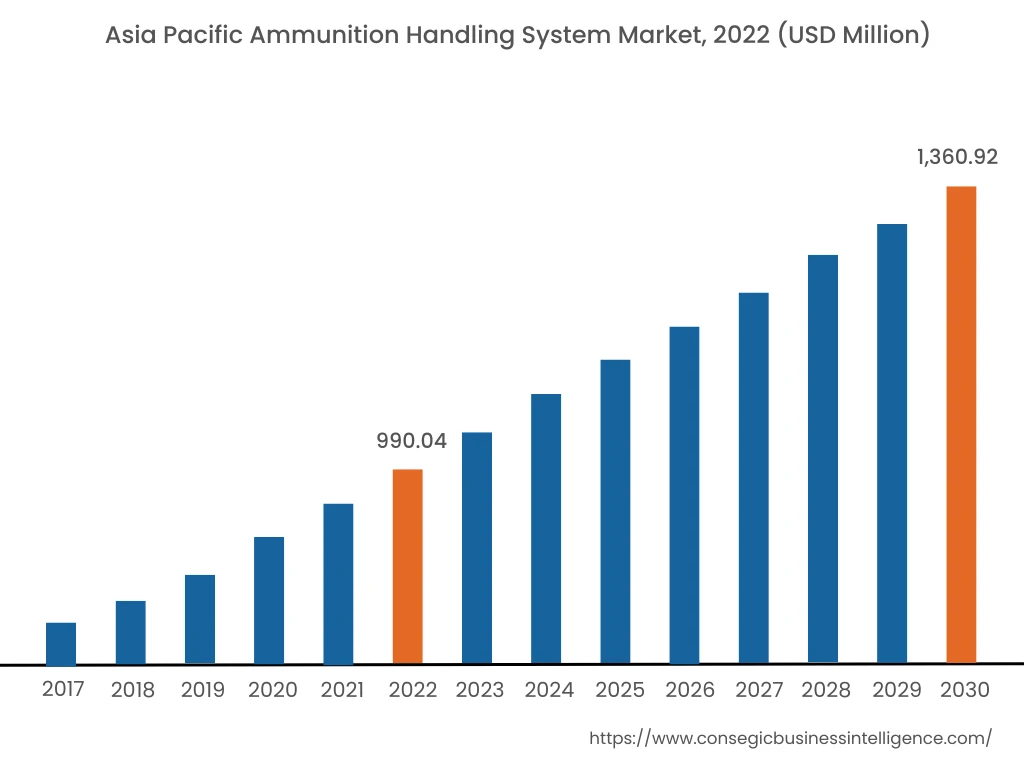
North America accounted for the largest revenue share in the year 2022. The increasing demand for safe and efficient management of ammunition in military & defense operations is driving the growth of the ammunition handling system market. North America is actively engaged in military operations that require advanced ammunition handling system to support rapid and efficient ammunition handling. Moreover, developments in the region including continuous technological advancements of automated ammunition handling system solutions are contributing to the growth of the market. Additionally, rising military & defense budgets in countries including U.S. and Canada is accelerating the adoption of advanced ammunition handling system solutions that further drives the growth of the regional market. For instance, U.S. current presidency has proposed a military budget request for USD 842 billion for the FY 2024, accounting for USD 26 billion increase from the FY 2023 budget.
The Asia-Pacific region accounted for a revenue share of USD 990.04 Million in 2022 and is expected to reach USD 1,360.92 Million in 2030 registering a CAGR of 4.3% during the forecast period. In addition, in the region, China accounted for a revenue share of 27.9% in the same year. Asia-Pacific region is characterized by various geopolitical tensions and security concerns, including territorial disputes and regional rivalries. Therefore, efficient and secure ammunition handling systems are essential to safeguard ammunition during their storage and transportation. Moreover, the increasing manufacturing and exports of military weapons and ammunition is driving the growth of the market. For instance, according to the United Nations COMTRADE database, the exports of arms, ammunition, parts and accessories in India was valued USD 252.96 Million in 2022.
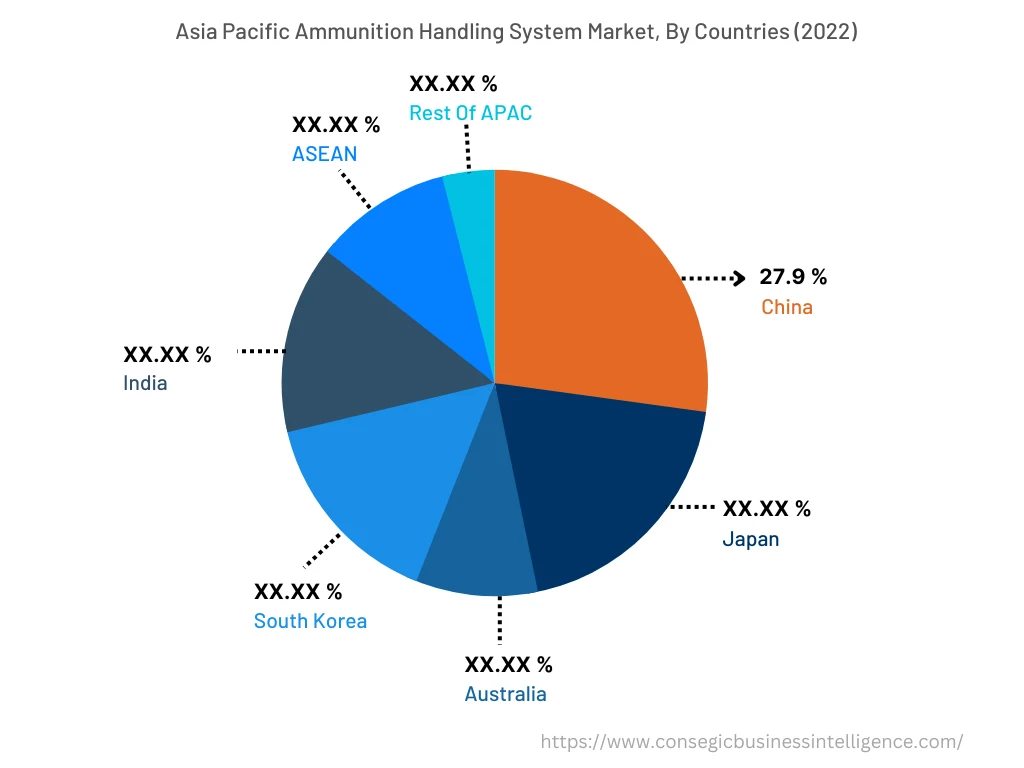
Top Key Players & Market Share Insights:
The ammunition handling system market is highly competitive with major players providing arms, ammunition, parts and accessories. Key players are adopting several strategies in product innovation, research and development (R&D), and various business strategies, and application launches have accelerated the growth of the ammunition handling system market. Key players in the ammunition handling system market include -
- BAE Systems
- Boeing
- Curtiss-Wright
- Dillon Aero
- General Dynamics Corporation
- GSI International
- Lockheed Martin
- Mcnally Industries
- Meggitt Defense Systems
- Moog
- Thales Group
Recent Industry Developments :
- In July 2022, Krauss-Maffei Wegmann (KMW) and Elbit Systems collaborated for the development of Rocket Artillery System
- In January 2023, Rheinmetall signed a contract to produce 40mm ammunition for two European NATO Customers.
Key Questions Answered in the Report
What is Ammunition Handling System (AHS)? +
Ammunition Handling System (AHS) comprises of the systems, tools, and accessories that are used to handle ammunition safely and effectively.
What specific segmentation details are covered in the Ammunition Handling System (AHS) report, and how is the dominating segment impacting the market growth? +
The report consists of segments including platform, weapon type, feeding mechanism and mode of operation. Each segment has key dominating sub-segment being driven by the industry trends and market dynamics. For instance, by platform has witnessed land as the dominating segment in the year 2022, due to the increasing demand for land military weapons and ammunition.
What specific segmentation details are covered in the Ammunition Handling System (AHS) market report, and how is the fastest segment anticipated to impact the market growth? +
The report consists of segments including platform, weapon type, feeding mechanism and mode of operation. Each segment is projected to have the fastest-growing sub-segment being fueled by industry trends and drivers. For instance, by mode of operation segment has witnessed automatic as the fastest-growing segment during the forecast period due to the increasing demand for high speed firing in military operations.
Which region/country is anticipated to witness the highest CAGR during the forecast period, 2023-2030? +
Asia-Pacific region is expected to register fastest CAGR growth during the forecast period due to the rising number of territorial disputes and regional rivalries.
